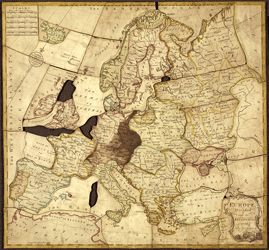|
Ted Carlton of Utah correctly identified one of the first jigsaw puzzles.
This photo is of one of the first jigsaw puzzles, and it was created by John Spilsbury in England in 1767-1777. Spilsbury was a cartographer and engraver, and he created his first puzzle in about 1760. He laid one of his world maps on wood and cut out the countries with a fine saw. His goal was to create a teaching aid for learning geography.
From the British Library: “In the space of two years, he marketed the eight map subjects most likely to appeal to upper class English parents: the world, the four continents then known (Africa, America, Asia and Europe), England and Wales, Ireland and Scotland.”
Spilsbury’s jigsaw puzzle was a great success—even though he did not call it a “jigsaw puzzle” at the time since jigsaws weren’t invented until 1947. Spilsbury referred to his creation as a “dissection” or “map dissection.” The name jigsaw puzzle actually came into being in the late 1800s when fretsaws were used to cut puzzle pieces.
Spilsbury also did not cut his puzzles with interlocking pieces. That feature of jigsaw puzzles did not appear until the late 1800s.
|

John Spilsbury’s 1766 jigsaw puzzle of a map of Europe. A rare survivor, only one other Spilsbury map is known to exist in a British public collection. (Photo, courtesy of and © The British Library Board, Maps 188.v.12.)
|
Both Parker Bros. and Milton Bradley sold millions of puzzles for children and adults. “In 1880, Milton Bradley made the first jigsaw puzzle for children, The Smashed Up Locomotive. By printing a lithograph of a steam engine locomotive and cutting it into pieces, the ‘smashed up’ effect was achieved when a child opened the box and saw the locomotive all in pieces. Because of his Puritan upbringing, Bradley's nature was to seek order. Therefore, the object of the The Smashed Up Locomotive was to make the locomotive whole once again.”1
Jigsaw puzzle sales skyrocketed during the dark days of the Great Depression. From early in 1932 to just one year later, sales leaped exponentially from two million jigsaw puzzles sold per week to 10 million. Jigsaw puzzles were a relatively cheap diversion, like the movies were at the time, and they were also a recyclable diversion. They were played multiple times and traded in puzzle clubs. Plus, stores rented jigsaw puzzles.2
After the Depression and the World War II years, the jigsaw puzzle craze subsided to just a popular pastime, and sales of wooden puzzles waned because of the cost. Today, it is postulated (since no official sales numbers are kept) that millions of jigsaw puzzles are sold each year, a far cry from 10 million per week in 1933.
With so many jigsaw puzzles created, almost every image under the sun has been die cut into a puzzle. Everything from The Last Supper by Leonardo da Vinci to big-eyed kittens has been made into jigsaw puzzles.
For the moment, the world's largest commercial jigsaw puzzle is “Double Retrospect” by Keith Haring with 32,256 pieces. It measures 17’ by 6’ and weighs 40 lbs in the box. The largest noncommercial puzzle has 551,232 pieces and measures 48’8” by 76’1”. It was created in Vietnam by students at the University of Economics in Ho Chi Minh City in 2011. Of course, these records are just waiting to be broken.3
Jigthings.com offers this advice about solving jigsaw puzzles:
1. The fastest way to do a jigsaw is to sort all the different colors into groups before you begin.
2. For a 1,000-piece jigsaw, it will take you about 30 minutes to get all the pieces sorted the right way up with the straight edge pieces separated out. You need to double this time to sort all the pieces into rough groupings of color.
3. Although it may seem odd, it will take you four times as long to do a 1,000-piece jigsaw as it will to do a 500-piece jigsaw. This is because each time you double the number of pieces, you quadruple the difficulty. Before you start a 4,000-piece jigsaw, bear in mind that it will take you 64 times longer to complete it than to do a 500-piece one.
---------------------------------------------
1
www.ideafinder.com/history/inventions/jigpuzzle.htm
2 William Young, The 1930’s, p. 132.
3 Hubpages©, aliciac.hubpages.com/
|